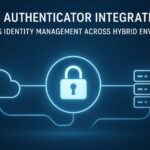In today’s complex IT ecosystem, organizations are rapidly shifting to hybrid environments—a mix of on-premises infrastructure, cloud services, and remote endpoints. This hybrid model improves scalability and flexibility but also introduces significant identity and access management (IAM) challenges. Managing user identities across multiple platforms, ensuring secure access, and maintaining compliance have become top priorities for IT leaders.
That’s where Forti Authenticator plays a crucial role. As a comprehensive identity management solution, Forti Authenticator seamlessly integrates with both cloud and on-premises systems, enabling unified authentication and centralized identity control across distributed networks.
This blog explores how Forti Authenticator simplifies hybrid identity management, its key integration capabilities, and best practices for deployment in multi-environment enterprises.
Understanding the Need for Unified Identity Management
In hybrid networks, users may access corporate resources from multiple devices, locations, and platforms. Each access point—whether a cloud-based SaaS app, VPN, or internal database—presents potential vulnerabilities if identity verification is inconsistent.
Traditional authentication systems often operate in silos, creating friction for users and complexity for administrators. Organizations need a centralized, automated solution to enforce consistent authentication policies everywhere. Forti Authenticator fulfills this requirement by acting as the backbone of identity management across hybrid ecosystems.
What Is Forti Authenticator Integration?
Forti Authenticator integration refers to the process of connecting Forti Authenticator with other IT infrastructure components such as FortiGate firewalls, Active Directory (AD), LDAP servers, SAML applications, and cloud identity providers.
Through these integrations, organizations can:
- Centralize user identity verification
- Enforce Multi-Factor Authentication (MFA) across cloud and on-premises resources
- Support Single Sign-On (SSO) for seamless access
- Apply consistent security policies regardless of where users log in
This unified approach strengthens security, reduces administrative overhead, and enhances the user experience.
Key Forti Authenticator Integration Capabilities
- Integration with FortiGate for Network Access Control
Forti Authenticator works hand in hand with FortiGate firewalls to verify user identities before granting network access. When a user attempts to connect via VPN or wireless, Forti Authenticator validates credentials, tokens, or certificates to ensure secure entry.
- Enables MFA for VPN access
- Supports RADIUS and TACACS+ authentication
- Ensures role-based access across the network
This integration is essential for organizations implementing Zero Trust Network Access (ZTNA) policies.
- Active Directory and LDAP Synchronization
Centralized identity synchronization eliminates the need to manually manage users in multiple systems.
- Forti Authenticator integrates with Microsoft Active Directory (AD) or LDAP to synchronize users and groups.
- Changes in AD (like user creation, modification, or deletion) automatically reflect in Forti Authenticator.
- Streamlines onboarding, deprovisioning, and access control.
This integration ensures consistent identity governance across on-premises and cloud resources.
- SAML and OAuth for Cloud Applications
Modern enterprises rely on SaaS platforms like Office 365, Salesforce, and AWS. Forti Authenticator extends secure access to these services through SAML 2.0 and OAuth integration.
- Enables Single Sign-On (SSO) across cloud and enterprise applications.
- Reduces password fatigue and enhances user convenience.
- Allows centralized auditing of user activity across cloud apps.
This capability is key to bridging the identity gap between traditional systems and cloud-based tools.
- Certificate Authority (CA) Integration for Device Authentication
In hybrid environments, securing endpoints is as important as securing users. Forti Authenticator includes a built-in Certificate Authority (CA) that issues digital certificates for trusted devices.
- Facilitates certificate-based authentication for Wi-Fi, VPN, and wired networks.
- Ensures only authorized devices can access business resources.
- Automates certificate renewal and revocation processes.
This strengthens endpoint security while simplifying compliance audits.
- API and Third-Party Integration
Forti Authenticator provides RESTful APIs that allow seamless integration with third-party systems and custom workflows.
- Integrate with existing Identity Providers (IdPs) and Security Information and Event Management (SIEM) tools.
- Automate token management, provisioning, and event logging.
- Extend authentication to proprietary enterprise apps.
This open integration capability makes Forti Authenticator adaptable to diverse IT ecosystems.
Benefits of Unified Identity Management with Forti Authenticator
- Consistent Security Policies: Uniform authentication standards across hybrid networks.
- Improved Compliance: Centralized logging and reporting help meet regulatory requirements.
- Operational Efficiency: Automated synchronization reduces admin workload.
- Enhanced User Experience: SSO and MFA reduce login friction while maintaining security.
- Scalability: Easily supports growing hybrid infrastructures and remote workforces.
By integrating identity across all access points, Forti Authenticator empowers businesses to secure both cloud and on-premises resources effectively.
Best Practices for Effective Integration
- Plan Integration Scope: Identify all systems—VPNs, AD, cloud apps—that will connect to Forti Authenticator.
- Enable MFA Everywhere: Protect every login point with MFA for both users and administrators.
- Leverage Certificates for Device Trust: Use certificate-based authentication for IoT and mobile devices.
- Monitor Logs and Reports: Regularly review Forti Authenticator logs for anomalies or access violations.
- Test Before Full Deployment: Validate integration with a pilot group before rolling out organization-wide.
These practices ensure a smooth, secure, and efficient identity integration experience.
Forti Authenticator in a Hybrid Security Strategy
Hybrid environments demand flexible yet consistent identity verification. Forti Authenticator complements Fortinet’s Security Fabric by connecting user identity to network access, cloud services, and endpoint verification. This ensures that every access request—regardless of location—is validated against unified security policies.
By combining Zero Trust principles, MFA, and SSO, Forti Authenticator becomes the linchpin for secure digital transformation.
In Conclusion
Forti Authenticator provides organizations with a unified and scalable approach to managing user identities across hybrid infrastructures. Its seamless integration with FortiGate, Active Directory, cloud apps, and third-party tools eliminates identity silos and enhances security visibility.
In conclusion, Forti Authenticator transforms identity management by bridging the gap between traditional and modern IT environments. By unifying authentication across on-premises and cloud platforms, it empowers businesses to maintain consistent, compliant, and user-friendly access control—no matter where users work or which systems they use.

